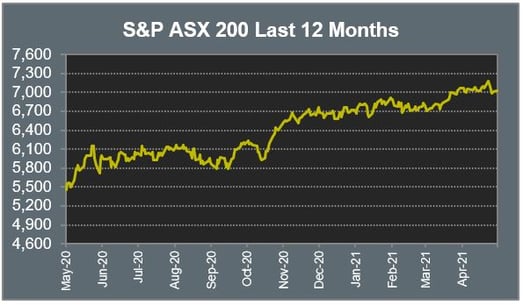Pre-Open Data

Key Data for the Week
- Monday – CHINA – Industrial Production fell to 9.8% from 14.1%.
- Monday – CHINA – Retail Sales showed 17.7% growth, missing expectations by 8.0%.
- Tuesday – AUS – RBA Meeting Minutes
- Tuesday – UK – Unemployment Rate

Australian Market
The Australian sharemarket added 0.1% on Monday, with gains limited by concerns of a slowing Chinese economy. The Information Technology sector was the best performer in the day’s trade, adding 1.2% to rebound from a large decline last week. This was largely due to gains in accounting software provider Xero, which added 5.6%.
The Materials sector provided widespread gains, aided by increases in the price of gold. This led to Northern Star Resources lifting 6.6%, Evolution Mining adding 5.4% and Gold Road Resources climbing 4.5%. Fortescue Metals was the best of the mining giants, increasing 1.4%, while BHP eked out a less than 0.1% gain.
Gains were also seen in the Energy sector, which closed 1.1% higher. Oil producers Santos and Oil Search added 1.0% and 0.8% respectively, while Origin Energy lifted 0.5%.
Performances in the Financials sector were mixed; Commonwealth Bank was the only big four bank to record a gain at the close of the session, up 1.25%. In contrast, NAB lost 0.7%, ANZ conceded 0.4% and Westpac fell 0.3%.
The Australian futures market points to a 0.16% rise today.
Overseas Markets
European sharemarkets closed flat on Monday, as weakened Chinese economic data dampened optimism around the re-opening of the British economy. The Travel and Leisure sector was among the worst performers, down 2.3%, as new COVID-19 cases in Asia re-affirmed the belief that international travel still poses many risks. The broad based STOXX Europe 600 lost less than 0.1%.
US sharemarkets fell on Monday, with the Information Technology sector weighing on the indices as Microsoft lost 1.2%, Apple fell 0.9% and PayPal shed 0.8%. The Utilities and Telecommunications sectors both closed between 0.7% and 0.9% lower. By the close of trade, the Dow Jones lost 0.2%, the S&P 500 shed 0.3% and the NASDAQ fell 0.4%.
CNIS Perspective
Since CoreLogic house price data commenced in 1980, there have been recessions in the early 80s, 90s and 2020. The economic slowdown post-GFC was significant, but it didn’t trigger a technical recession.
During these times dwelling prices declined, with the recession of 1990 and GFC downturn recording falls of around 7.0%. The 2020 recession caused by COVID resulted in a smaller fall, but a recovery swifter than previous recessions and GFC.
Property prices post-COVID returned to their 2020 peak within eight months, while previous recessions and the GFC took between 18 to 24 months for prices to return to their pre-downturn peak.
The turnaround is due to a number of factors. The economy and labour market has rebounded much faster than other downturns and interest rates are at a record low.
On the supply side, the low level of housing stock is also helping to propel prices higher, with advertised listings more than 30% below their average in the five years before the pandemic.
The big question is - when will the regulators start applying the brakes?
It appears only a matter of time before limits are imposed on the lenders similar to 2015 and 2017, when a 10% limit was imposed on investor loan growth and a 30% limit on the share of interest only loans.
It’s never healthy for a market to run too hard, too fast and create a bubble. There’s obviously more strength in the property market in the short term, but the pace of growth has to slow if a bubble is to be avoided.

Should you wish to discuss this or any other investment related matter, please contact your Investment Services Team on (02) 4928 8500.
Disclaimer
The material contained in this publication is the nature of the general comment only, and neither purports, nor is intended to be advice on any particular matter. Persons should not act nor rely upon any information contained in or implied by this publication without seeking appropriate professional advice which relates specifically to his/her particular circumstances. Cutcher & Neale Investment Services Pty Limited expressly disclaim all and any liability to any person, whether a client of Cutcher & Neale Investment Services Pty Limited or not, who acts or fails to act as a consequence of reliance upon the whole or any part of this publication.
Cutcher & Neale Investment Services Pty Limited ABN 38 107 536 783 is a Corporate Authorised Representative of Cutcher & Neale Financial Services Pty Ltd ABN 22 160 682 879 AFSL 433814.
Cutcher's Investment Lens | 7 - 11 April 2025
The failed $3 million super tax: Division 296 is done… or is it?
Cutcher's Investment Lens - Update on Trump & Tariffs | 31 March - 4 April 2025
Liberation Day - April 2025 Snapshot
Smart investing for SMEs: The basics on how to get started and grow your business.



